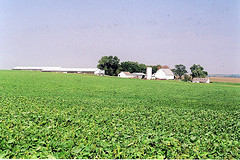
flic.kr/p/b29eAa
Where and how did lecithin get its name? Was it named after some brilliant scientists who discovered it while working night and day in a laboratory? In fact, the real story is a little blander than that. Lecithin actually comes from the word “lekithos”, which is the Greek word for “egg yolk.”
But why would anyone name it after something so common as an egg yolk? The reason is because that is where the French scientist Maurice Gobley first found lecithin. In 1805, some scientists had just extracted a fat-like substance from the yolk of an egg. He further discovered that it contained properties very similar to those of an emulsifier.
Since then, the major source for commercial lecithin had always been eggs. But in the 1930s, it was discovered that soy lecithin could also be recovered from the waste product of soybean processing.
Today, only a few people can distinguish between soy lecithin and egg lecithin. The term has been used as a generic word referring to a whole class of fat and water soluble compounds called phospholipids.
Where Soy Lecithin Originated
Soy lecithin, as mentioned earlier, is a by product of soybean processing. Initially, the soybeans are tempered by keeping them at a consistent temperature and moisture level for approximately 7 to 10 days. This has a hydrating effect on the soybeans, loosening it from its hull.
After this, the soybeans are cleaned and cracked into small pieces. The cracked beans are segregated from the hulls and are heated and pressed into flakes.
Next, the flakes undergo a distillation process where the soybean oil is extracted, then crude soy oil is made to undergo a “degumming” process. The sludge that is produced as a result of “degumming” is where soy lecithin comes from. In addition, the sludge would have to undergo another process first, to extract the lecithin.
Normally, the waste product contains solvents and pesticides that could be harmful if not purified through a process called the hexane extraction. This process, however, actually yields less soy lecithin than the older ethanol benzol process. But this process also produces a more marketable lecithin with better color, reduced odor and less bitter flavor.
Why are they good?
The food industry makes use of soy lecithin for a variety of purposes. As an emulsifier, the substance helps promote solidity in margarine and provides consistent texture to dressings and other creamy products. It is also used in coatings and chocolates and to counteract spattering during frying. Lecithin has been tagged by the U.S. Food and Drug Administration as one of the few emulsifiers that is safe for use by consumers.
But while soy lecithin is more popular for its emulsifying properties, it has a lot more to offer. Its unique lipid molecular structure makes it useful for cosmetic and pharmaceutical application. Additionally, it is also utilized for a variety of industrial purposes, including textiles, paints, lubricants, and waxes.
Lecithin is also considered as having beneficial effects to our health. The substance generally contains three kinds of phospholipids: phosphatidylcholine (PC), phosphatidylethanolamine (PE), and phosphotidylinositol (PI). Phosphatidylcholine contains the element choline, which is essential to every living cell in the body and is one of the major components of cell membranes. It appears that majority of the health claims about soy lecithin may have something to do with the fact that it is an excellent source of choline.
Tagged with: lecithin benefits • soya beans
Filed under: Lecithin